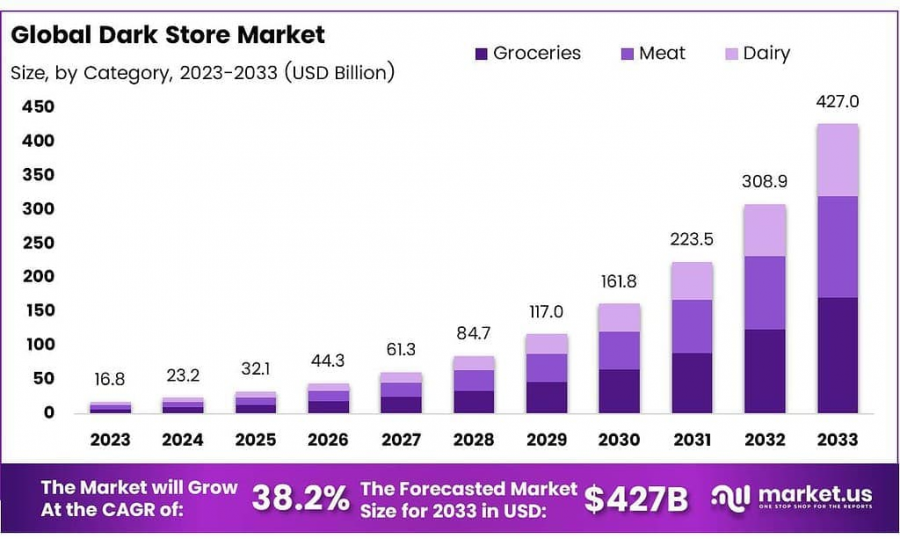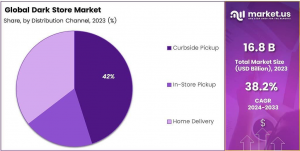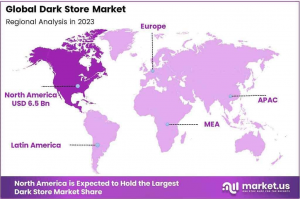
Dark Store Market to Reach USD 427B by 2033, Growing at 38.2% CAGR
Dark Store Market to Reach 427B USD by 2033 from 16.8B USD in 2023 at 38.2% CAGR
NEW YORK, NY, UNITED STATES, February 6, 2025 /EINPresswire.com/ -- Market Overview
The Global Dark Store Market size is expected to be worth around USD 427 Bn by 2033, from USD 16.8 Bn in 2023, growing at a CAGR of 38.2% during the forecast period from 2024 to 2033.
The Dark Store Market refers to retail spaces that are dedicated solely to online order fulfillment rather than direct consumer interaction. These stores are strategically located in urban areas to optimize quick inventory processing and dispatching of online orders. Unlike traditional retail stores, dark stores focus on storage and order processing, without the need for public-facing shopping areas. As e-commerce demand increases, dark stores have become a vital part of retailers’ logistics and supply chain strategies, enabling faster and more efficient delivery services.
The market for dark stores has experienced substantial growth, largely driven by the rise of e-commerce and consumers’ growing demand for fast, on-demand delivery. Retailers are increasingly adopting dark store models to meet these demands by streamlining their order fulfillment processes. With advancements in logistics technology and last-mile delivery solutions, dark stores have become essential to providing quicker, cost-effective services, particularly in urban areas. As consumers shift towards online shopping for its convenience, dark stores are positioned to thrive as the future of retail evolves.
Government investments in urban infrastructure and logistics hubs are contributing to the growth of the dark store market. Policies aimed at modernizing supply chains and promoting efficient delivery systems support the adoption of dark store operations. At the same time, regulatory frameworks are adapting to this new retail model, with governments introducing zoning laws to facilitate the integration of dark stores into urban areas. Sustainability is also a key concern, leading to regulations encouraging energy-efficient facilities and environmentally conscious distribution systems.
For both new and existing players, there are numerous growth opportunities in the dark store market. New entrants can capitalize on the demand for fast deliveries by offering solutions that improve inventory management and last-mile delivery efficiency. Established players can expand their dark store networks, leveraging technology like automation and AI to enhance order processing. By optimizing operations and forming strategic partnerships, businesses can strengthen their position in this rapidly growing market.
Curious About Market Trends? Request Your Complimentary Sample Report Today: https://market.us/report/dark-store-market/free-sample/
Key Takeaway
• Rapid Growth: The Global Dark Store Market is projected to expand from USD 16.8 billion in 2023 to USD 427 Bn billion by 2033, with a CAGR of 38.2%.
• Grocery Dominance: Groceries captured a 40% share in 2023, driven by consumer demand for quick, convenient shopping, especially for meat and dairy.
• Adults Lead Consumption: Adults with higher disposable incomes constituted the largest market segment in 2023, holding a 39% share.
• Preference for Curbside Pickup: This distribution channel led in 2023 with a 42% share, favored for its speedy and contactless service.
• North America’s Market Leadership: Held a significant 39.2% market share in 2023, supported by advanced e-commerce and logistics.
• Shift to Subscriptions: The trend towards subscription-based models is enhancing customer retention and demanding efficient operations from dark stores.
• AI in Logistics: Dark stores are crucial for improving last-mile delivery, with AI and machine learning enhancing inventory management and operational efficiency.
Use Cases
1. E-commerce Fulfillment Centers: Dark stores are primarily used as e-commerce fulfillment centers, where products are stocked and orders are prepared for online shoppers. They act as local warehouses for quick delivery, enabling retailers to fulfill online orders faster and more efficiently. This model is gaining traction as more consumers turn to online shopping for groceries and everyday items.
2. Last-Mile Delivery Efficiency: Dark stores are a key component of improving last-mile delivery, especially in urban areas. Since they are typically located close to densely populated regions, they can facilitate rapid delivery of goods to customers within a short time frame, making them particularly attractive to customers who want same-day or next-day delivery.
3. Grocery Delivery Services: The rise of online grocery shopping has boosted the dark store market. Retailers like Amazon, Walmart, and local players are increasingly adopting dark stores for grocery deliveries. With dark stores dedicated solely to fulfilling grocery orders, these retailers can provide fresher produce and maintain inventory more effectively.
4. Cost-Effective Retail Expansion: Dark stores offer a cost-effective solution for retailers who want to expand their reach without investing in traditional brick-and-mortar stores. They allow retailers to save on rent, utilities, and staffing costs while still offering extensive product ranges to customers via online platforms.
5. Contactless and Safe Shopping Experience: In the wake of the COVID-19 pandemic, dark stores became essential for providing a safe, contactless shopping experience. Consumers looking for a quick, no-contact way to shop online for essentials can rely on dark stores for a smoother and safer transaction, which is likely to continue to influence consumer behavior in the post-pandemic era.
Driving Factors
1. Surge in Online Shopping
The rapid growth of e-commerce is the primary driver behind the dark store market. Consumers are shopping more online than ever before, seeking convenience and faster delivery options. Dark stores are designed to cater specifically to online orders, allowing retailers to handle fulfillment in a more efficient and cost-effective manner. With the rise of platforms like Amazon and other online retailers, the demand for fulfillment centers in urban areas has significantly increased, accelerating the growth of dark stores.
2. Need for Faster Delivery and Last-Mile Fulfillment
One of the biggest challenges in e-commerce is ensuring fast and accurate delivery to customers. Dark stores, located closer to high-demand areas, help improve last-mile delivery efficiency. This allows retailers to provide faster delivery times—often within hours or the same day. As consumers demand faster services, especially for groceries, food delivery, and daily essentials, dark stores have become a key component in meeting those expectations. The rise of on-demand delivery services like Instacart and Uber Eats further fuels this trend.
3. Cost-Effective Retail Model
Dark stores help retailers cut down on the operational costs associated with traditional brick-and-mortar stores. Without the need to maintain a storefront for walk-in customers, retailers can streamline their operations and focus purely on inventory management and order fulfillment. This model not only reduces overhead costs but also optimizes supply chain logistics by consolidating the warehousing and picking process into one location. As a result, retailers can pass on cost savings to customers or reinvest in improving their services.
4. Increased Investment in Technology
The dark store model relies heavily on automation and technology to ensure smooth operations. Advances in warehouse management systems, robotics, and AI-driven inventory tracking are helping dark stores operate more efficiently. Automated picking systems, for example, speed up the process of order fulfillment and reduce human error. Investment in technology also enhances the ability to track customer preferences and optimize stock levels, improving both customer satisfaction and profitability.
5. Shift Toward Omnichannel Retailing
As consumers increasingly expect to shop seamlessly across multiple channels—whether online, via mobile apps, or in-store—the dark store model allows retailers to implement an effective omnichannel strategy. Dark stores serve as fulfillment centers for both online and click-and-collect orders, ensuring that consumers can access products regardless of the shopping method. This model enables retailers to meet the growing demand for convenience while also integrating with their broader multichannel retail strategies.
Report Segmentation
By Category
• Meat
• Dairy
• Groceries
By Age Group
• Elderly
• Children
• Adults
By Distribution Channel
• In-Store Pickup
• Curbside Pickup
• Home Delivery
Ready to Act on Market Opportunities? Buy Your Report Now and Get Upto 30% off: https://market.us/purchase-report/?report_id=130859
Regional Analysis
In 2023, North America held a dominant 39.2% share of the global dark store market, a trend driven by the region's advanced e-commerce infrastructure and sophisticated logistics systems. Dark stores, which are retail locations optimized for online order fulfillment rather than in-store shopping, have become increasingly popular as consumers shift toward digital shopping experiences. This growth is largely attributed to the rising demand for faster, more efficient delivery services, especially for groceries and other everyday products.
The region's robust e-commerce ecosystem, supported by tech giants like Amazon and major grocery chains, has been pivotal in driving the adoption of dark stores. These stores are strategically located in urban centers to enable rapid order processing and same-day or next-day deliveries, providing a competitive edge in an increasingly fast-paced retail environment. Additionally, North America's highly developed logistics networks, which include automated warehouses, delivery optimization software, and well-established last-mile delivery solutions, ensure that dark stores can efficiently manage large volumes of orders.
Growth Opportunities
Increase in Online Shopping: The rise in e-commerce and the shift toward online shopping have created a significant demand for dark stores, which are retail outlets set up for fulfilling online orders rather than serving customers in-store. With more people preferring the convenience of shopping from home, dark stores offer fast, localized order fulfillment, especially for groceries, essentials, and even electronics. Companies can capitalize on this trend by setting up dark stores in urban areas with high online shopping activity.
Expanding Quick Commerce and Delivery Services: The growing demand for instant" or "quick" delivery services (usually within an hour or two) presents an opportunity for dark stores to meet this need. By optimizing their supply chains and inventory management systems, businesses can cater to customers who want to get their products delivered fast. Integrating dark stores into a quick-commerce strategy could be a game-changer for retailers looking to meet the increasing demand for convenience.
Increased Investment in Automation and Robotics: As e-commerce grows, the need for efficient order fulfillment increases. Dark stores can incorporate automation, robotics, and artificial intelligence (AI) to streamline picking, packing, and shipping processes. This would not only improve operational efficiency but also reduce labor costs and errors, leading to faster and more reliable delivery. Companies investing in advanced technology for their dark stores can gain a competitive edge.
Focus on Localizing Fulfillment Centers: With the focus shifting to delivering products quickly, there's a need for more strategically placed dark stores close to residential areas. Localizing fulfillment centers closer to customers helps reduce delivery time, making it easier for consumers to receive orders faster. Dark stores in key locations within cities or densely populated areas can cater to this demand, increasing customer satisfaction and repeat business.
Partnerships with Grocery and Perishable Goods Retailers: Grocery and perishable goods retailers are increasingly using dark stores to fulfill online grocery orders due to the need for swift, temperature-controlled delivery. By setting up dedicated dark stores for perishable products, retailers can address growing demand for fresh food delivery, ensuring better quality and faster turnaround times for their customers. This trend could be further supported by offering subscription services, where customers can receive regular deliveries of fresh goods."
Key Players
• Amazon.com, Inc.
• Walmart, Inc.
• Supermarket Grocery Supplies Pvt Ltd.
• Swiggy
• Target Brands, Inc
• Uber
• Wolt
• Grab
• Auchan
• Dunzo Daily
• Flipkart
• Instacart
• Ola Foods
Not Sure? Request a Sample Report and See How Our Insights Can Drive Your Business: https://market.us/report/dark-store-market/free-sample/
Conclusion
In conclusion, the markets analyzed are all experiencing growth driven by evolving consumer preferences, technological advancements, and increasing demand for customized, high-quality products. Key trends, such as the adoption of sustainable practices, integration of smart technologies, and rising disposable incomes, are shaping the competitive landscape. While challenges such as market saturation, price sensitivity, and regional differences persist, opportunities abound for companies to capitalize on niche segments, leverage digital platforms, and innovate to meet the specific needs of their target audiences. As these industries continue to expand, businesses that adapt to changing trends, prioritize customer-centric strategies, and invest in innovation will be well-positioned for long-term success.
Related Report
Envelope Paper Market: https://market.us/report/envelope-paper-market/
Department Stores Market: https://market.us/report/department-stores-market/
Gift Wrapping Products Market: https://market.us/report/gift-wrapping-products-market/
Vacation Rental Market: https://market.us/report/vacation-rental-market/
Knife Market: https://market.us/report/knife-market/
Lawrence John
Prudour
+91 91308 55334
Lawrence@prudour.com
Distribution channels: Retail
Legal Disclaimer:
EIN Presswire provides this news content "as is" without warranty of any kind. We do not accept any responsibility or liability for the accuracy, content, images, videos, licenses, completeness, legality, or reliability of the information contained in this article. If you have any complaints or copyright issues related to this article, kindly contact the author above.
Submit your press release


